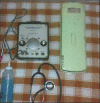Comparison of two walk tests in determining the claudication distance in patients suffering from peripheral arterial occlusive disease
- PMID: 26261825
- PMCID: PMC4513323
- DOI: 10.4103/2277-9175.158036
Comparison of two walk tests in determining the claudication distance in patients suffering from peripheral arterial occlusive disease
Abstract
Background: The purpose of this study was to compare the six-minute walk test (6MWT) and the incremental shuttle walk test (ISWT) in terms of the initial onset of pain (IOP), maximal claudicating pain (MCP), maximum walking distance (MWD), initial ankle brachial index (IABI), post ankle brachial index (PABI), and difference in ankle brachial index (DFABI), as well as to correlate changes in IOP and MWD, MCP and MWD, IABI and MWD, PABI and MWD, and DFABI and MWD in the 6MWT and ISWT.
Materials and methods: Participants (n = 19, 17 men and 2 women) were randomly allocated to the 6MWT or ISWT and crossed over to the other test after 24 hours. The baseline ankle brachial index (ABI) measurements were taken using the Doppler, following which the participants performed the tests. Post-test MWD, IOP, MCP, and ABI were measured. The paired t test was used pre- and post the walk test and the Pearson correlation was used to find any relationship between the desired variables.
Results: The paired t test at 95% confidence interval for IABI and PABI (P > 0.05) was insignificant for the 6MWT and ISWT. The Pearson correlation of MWD with IOP showed a fair correlation, and the correlation of MWD to MCP showed a strong correlation in ISWT.
Conclusion: ISWT can be of vital importance as a tool to assess the functional status of patients suffering from Peripheral Arterial Occlusive Disease (PAOD) in both the clinical and research areas, and reflects a better assessment of the functional limitation when walking with PAOD as compared to the 6MWT.
Keywords: Initial onset of pain; maximal claudicating pain; maximum walking distance; peripheral arterial occlusive disease; walking tests.
Conflict of interest statement
Figures
References
-
- Creager MA, Loscalzo J. Vascular diseases of the extremities. In: Fauci AS, Braunwald E, Kasper DL, Hauser S, Longo DL, Jameson J, et al., editors. Harrison's Principles of Internal Medicine. 18th ed. U.S.A.: Tata McGraw-Hill Professional; 2008. p. 185.
-
- McDermott MM, Greenland P, Liu K, Guralnik JM, Celic L, Criqui MH, et al. The ankle brachial index is associated with leg function and physical activity: The walking and leg circulation study. Ann Intern Med. 2002;136:873–83. - PubMed
-
- Gardner AW, Katzel LI, Sorkin JD, Bradham DD, Hochberg MC, Flinn WR, et al. Exercise rehabilitation improves functional outcomes and peripheral circulation in patients with intermittent claudication: A randomized controlled trial. J Am Geriatr Soc. 2001;49:755–62. - PubMed
-
- Hirsch AT, Haskal ZJ, Hertzer NR, Bakal CW, Creager MA, Halperin JL, et al. Bethesda, Maryland: American College of Cardiology Foundation; 2005. ACC/AHA 2005 Guidelines for the Management of Patients with Peripheral Arterial Disease (Lower Extremity, Renal, Mesenteric, and Abdominal Aortic): A Collaborative Report [Trunc] p. 192. - PubMed
-
- Zwierska I, Nawaz S, Walker RD, Wood RF, Pockley AG, Saxton JM. Treadmill versus shuttle walk tests of walking ability in intermittent claudication. Med Sci Sports Exerc. 2004;36:1835–40. - PubMed
LinkOut - more resources
Full Text Sources
Other Literature Sources
Miscellaneous



